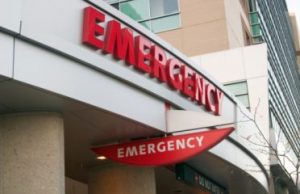
Are you having trouble deciding to go to A&E?
If so, here are 10 common reasons to go to A&E.
If you have any if them, you should consider it. CRASH-CABIN is a useful acronym.
If you do not have one of these, you should be thinking of an alternative NHS service.
We will now go through these 10 common reasons to go to A&E.
For each, we will state the more serious (or more common) causes of the problem.
1. Chest pain
Chest pain is one of the most common reasons why people visit A&E. The more serious causes can lead to cardiac arrest, which will need A&E care. Pneumothorax and aortic dissection need rapid action (chest drain and surgery respectively).
These situations are common in A&E, but many patients survive.
2. Shortness-of-breath
Infections and viruses are another common cause of people visiting A&E. The flu and common cold (and now COVID-19) are widespread diseases. They can be mild illnesses, but may require emergency treatment in severe cases. Heart failure and COPD (chronic obstructive pulmonary disease)/asthma are other common breathing problems.
3. Abdominal pain or bleeding
Many people visit A&E every day due to abdominal pain. They may be less serious (gastroenteritis) or may be a condition that needs surgery soon – e.g. appendicitis or a blocked bowel, or urgent investigation or pain relief (kidney stones).
4. Fractures and sprains
Broken bones and sprains are a common occurrence that can happen to anyone, regardless of their age or condition. They can be caused by accidents, playing sports or other physical activities. Not all sprains require A&E although broken bones need to be looked at immediately.
5. Accidents (significant)
Such accidents may be sport or work-related, or due to a road traffic accident (RTA).
Head injuries and cuts are one of the most common reasons why people visit A&E. They can occur through any activity and may require urgent attention. The majority of cuts are due to accidents with a glass or a knife. And if bleeding is severe, A&E is necessary.
6. Back pain
Another reason for visiting A&E is back pain. It can be due to an accident or physical injuries while playing sports or by lifting heavy things. Disc prolapses are very common. Most causes just need pain relief.
An MRI is not often necessary. But, the big BUT, if you have weakness in the arms or legs, or cannot control your wee or poo, this may indicate a very serious cause. And an urgent MRI is needed. Rapid neurosurgery (for spinal cord compression/cauda equina syndrome) may be required.
7. Infection (called ‘sepsis’ if severe) and allergies
An infection like a UTI, cellulitis or pneumonia (severe lung infection) can spread rapidly over the body in severe cases. All three can cause sepsis, which means severe infection. But any infection can cause it. It is life-threatening. Allergies can occur with medication or food, but anything can cause an allergy – and they are increasingly common.
8. Severe headache, or loss of vision
Headaches are very common. Therefore it is not surprising that headaches are one of the most common reasons for a person to visit A&E. Most are benign (not serious) and are tension headaches or migraine. But there are more serious causes including SAH, meningitis and encephalitis.
Note. If you have an new serious eye problem and think you need to see an eye doctor today, check your local A&E have an ‘eye casualty’ (i.e. eye doctors on site). If not, go to a bigger regional centre (even if it takes longer to get there) – today.
9. The 3 C’s = collapse, confusion or reduced conscious level
Collapse has many causes, from minor (mechanical) to very serious. This why it is hard to assess. Doctors worry most about heart (heart attack or heart failure), brain (epileptic fit or stroke) and metabolic (body chemistry) problems (e.g. diabetes, with too high or low blood glucose). Too much (or too little) drugs (prescribed or recreational) and alcohol also cause collapse.
10. Mental health problem (severe)
As there is no Mental Health A&E, people should go to A&E when they feel they are seriously mentally ill or suicidal.
What if my problem is not on this list?
You should ask yourself: ‘is A&E the best place for this problem?” and “where else could I go to be seen soon?”
We have described 10 common reasons to go to A&E. If you do not have one of these, you should be thinking of using an alternative NHS service. It may not be A&E or your GP. We hope it has helped you.
How are patients prioritised (triaged) in A&E?